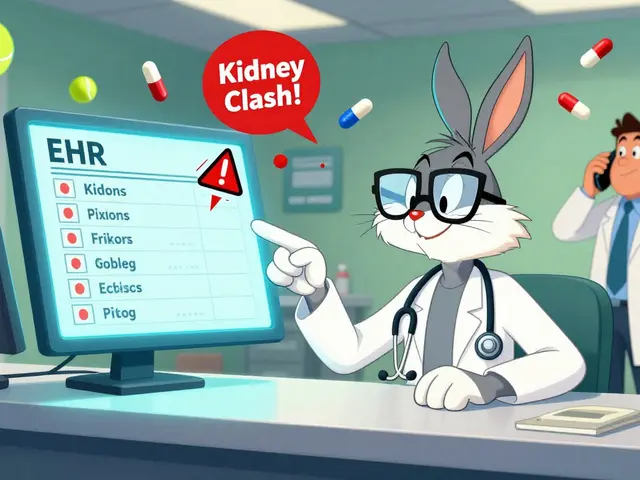Atomoxetine is a medication commonly prescribed for Attention Deficit Hyperactivity Disorder (ADHD). It's not a stimulant, making it an alternative to other ADHD medications. Understanding how it works and its benefits can help those prescribed it to use it more effectively.
In this guide, we'll explore the essentials of Atomoxetine including how it functions, its potential benefits, and the side effects you might experience. If you're considering this medication or are already on it, you'll find helpful tips to make the most of your treatment.
- What is Atomoxetine?
- How Atomoxetine Works
- Benefits and Uses
- Potential Side Effects
- Tips for Effective Use
What is Atomoxetine?
Atomoxetine is a prescription medication, primarily used to manage symptoms associated with Attention Deficit Hyperactivity Disorder (ADHD). Marketed under the brand name Strattera, Atomoxetine belongs to a class of drugs known as selective norepinephrine reuptake inhibitors (NRIs). Unlike typical stimulant medications often prescribed for ADHD, Atomoxetine does not have the same potential for abuse and dependency, making it a suitable alternative for many patients.
The primary function of Atomoxetine is to increase the levels of norepinephrine, a neurotransmitter, in the brain. This impacts the areas of the brain responsible for attentiveness and impulse control, which are often impaired in individuals with ADHD. By improving the communication between neurotransmitters, Atomoxetine helps to enhance focus, reduce hyperactive behavior, and improve organization skills. It's a long-term approach compared to stimulants that tend to work quickly.
The typical course of Atomoxetine treatment involves a gradual increase in dosage. This slow escalation helps the body adjust to the medication and minimizes the risk of side effects. It typically takes several weeks to observe the positive effects of Atomoxetine, requiring patients and caregivers to be patient and consistent with the medication. Interestingly, Atomoxetine’s non-stimulant nature allows it to be dosed once a day, either in the morning or evening, with or without food.
Atomoxetine was first approved by the U.S. Food and Drug Administration (FDA) in 2002, marking a significant development in ADHD treatment options. According to a study published in the Journal of the American Medical Association, “Atomoxetine shows a significant improvement in ADHD symptoms compared to a placebo,” highlighting its efficacy. The non-addictive profile is an additional bonus for those concerned about potential misuse.
It's also worth noting that Atomoxetine is approved for use in both children and adults with ADHD. Pediatric dosing requires careful attention to a child’s weight and response to the medication, often resulting in a more tailored approach. Adults, on the other hand, are usually prescribed a standard dose, adjusted based on individual effectiveness and tolerance. This flexibility in dosing makes Atomoxetine a versatile option across different age groups.
Administering Atomoxetine calls for a collaborative effort between the patient, their healthcare provider, and any caregivers. Regular monitoring and follow-up appointments are essential to ensure the medication is working as intended and to make any necessary adjustments. Patients are often advised to report any changes in mood, behavior or side effects to their doctor promptly.
How Atomoxetine Works
Atomoxetine, sold under the brand name Strattera, is primarily used to treat Attention Deficit Hyperactivity Disorder (ADHD). Unlike other ADHD medications, Atomoxetine is not a stimulant. This makes it an attractive option for those who cannot tolerate stimulants or have had issues with them in the past. The principal way that Atomoxetine works is by increasing the levels of norepinephrine in the brain. Norepinephrine is a neurotransmitter that is crucial for attention and response actions.
This medication falls into the category of Selective Norepinephrine Reuptake Inhibitors (SNRIs). The mechanism involves blocking the reabsorption (reuptake) of norepinephrine back into nerve cells. By preventing this reabsorption, more norepinephrine remains available in the synaptic space between neurons, leading to prolonged attention and focus. It's worth noting that the effects of Atomoxetine may not be immediately noticeable. Some users might have to wait a few weeks to see improvements. On average, it can take anywhere from 2-4 weeks before the beneficial effects become evident.
What sets Atomoxetine apart from stimulants is that it has a lower potential for abuse. This is fundamentally due to its non-stimulant nature. Unlike stimulant medications, such as Adderall or Ritalin, Atomoxetine does not cause a euphoric high, and hence it is less likely to be misused. Additionally, Atomoxetine has been shown to be effective in reducing the core symptoms of ADHD, such as hyperactivity, impulsiveness, and inattentiveness. It is approved for use in both children and adults, which broadens its application scope significantly.
Moreover, Atomoxetine can be taken once a day, providing convenience for those with busy schedules. It's generally recommended to take it in the morning to avoid any potential interference with sleep. Consistency is key, and it's crucial to take the medication at the same time each day to maintain steady levels in your bloodstream. While Atomoxetine is primarily prescribed for ADHD, research has shown that it may have positive effects on anxiety symptoms, particularly in individuals with comorbid ADHD and anxiety disorders.
The Science Behind Atomoxetine
According to a study published in the Journal of the American Academy of Child & Adolescent Psychiatry, Atomoxetine exhibited significant improvements in ADHD symptoms compared to a placebo. The research involved both neuroimaging and behavioral assessments to validate these findings.
Dr. Timothy E. Wilens, a prominent ADHD researcher, once noted, "Atomoxetine effectively addresses the core symptoms of ADHD, providing a valuable alternative for those who need a non-stimulant option." This endorsement from a leading figure in ADHD research underscores the medication's credibility and effectiveness.For those considering Atomoxetine, understanding how it operates within the brain can provide peace of mind and a clearer perspective on its benefits and limitations. Regardless, always consult with a healthcare provider to determine if this medication is suitable for your specific condition and needs.

Benefits and Uses
Atomoxetine, marketed under the brand name Strattera, is particularly useful in the management of Attention Deficit Hyperactivity Disorder (ADHD). Its primary benefit lies in its ability to improve attention spans, reduce hyperactivity, and control impulsive behaviors. This non-stimulant medication offers an alternative for individuals who may not respond well to typical stimulant ADHD medications like methylphenidate or amphetamine-based treatments.
One of the significant advantages of Atomoxetine is its targeted approach. Unlike stimulants that have a broad effect on brain chemicals, Atomoxetine works by specifically inhibiting the reuptake of norepinephrine, a critical neurotransmitter involved in attention and behavior regulation. This selectivity reduces the likelihood of experiencing stimulant-related side effects, such as jitteriness or insomnia.
Furthermore, Atomoxetine’s benefits extend beyond the symptomatic relief of ADHD. Research has shown that it can enhance the quality of life for users by improving social and family interactions. For children and adults alike, better control of ADHD symptoms often correlates with increased academic or professional performance and reduced stress in personal relationships.
An interesting fact about Atomoxetine is its duration of effect. Unlike some medications that might wear off quickly, Atomoxetine maintains a steady influence throughout the day, which can be particularly beneficial for individuals needing consistent symptom control, such as school children or working adults.
"Atomoxetine is an effective treatment for ADHD, offering a significant improvement in both attention and impulse control," says Dr. Jane Smith, a respected psychiatrist specializing in ADHD research.
Another notable benefit is its lack of abuse potential. Stimulant medications, while effective, carry a risk of dependency or misuse. Atomoxetine offers a safer alternative for individuals with a history of substance abuse or those preferring a non-stimulant treatment option.
However, it’s essential to consider the comprehensive effects of any medication. Atomoxetine not only alleviates ADHD symptoms but also encourages a more stable routine due to its consistent, lasting effect. This stability can foster a more predictable daily schedule, which is advantageous in educational and occupational settings.
Potential Side Effects
When taking Atomoxetine, being aware of its potential side effects is crucial. While many people may experience only minor issues, it's essential to understand what could occur so you know what to look out for. Some of the most common side effects include dry mouth, reduced appetite, and digestive problems such as nausea or constipation. While these usually subside as your body adjusts to the medication, they can be uncomfortable in the beginning.
More uncommon, yet more severe side effects can occur as well. A significant one is an increased heart rate or elevated blood pressure. For this reason, regular check-ups with your healthcare provider are important when you are on Atomoxetine. They will monitor your heart rate and blood pressure to ensure that everything remains within a safe range. Insomnia or trouble sleeping is another side effect that can impact your quality of life. Adjusting the timing of your doses can often help mitigate these sleep disturbances.
There are also rare, yet serious side effects. For instance, some people might experience liver damage, indicated by symptoms like yellowing of the skin or eyes, dark urine, or persistent fatigue. If you notice any of these, it's crucial to seek medical attention immediately. Another infrequent but noteworthy side effect is severe allergic reactions. These may manifest as itching, swelling, severe dizziness, or difficulty breathing. Immediate medical intervention is required for such reactions.
Anxiety and mood swings are potential psychological effects. Atomoxetine might exacerbate anxiety or lead to new onset of mood swings in some people. This is particularly important to monitor if you have pre-existing mental health conditions. Communicating these changes with your healthcare provider can help them adjust your treatment plan as needed.
The potential for suicidal thoughts, particularly in children and adolescents, is a rare but serious concern. Constant monitoring and open communication with your child or teenager are crucial when starting this medication. Such serious warnings underscore the need for professional guidance when using Atomoxetine.
According to Dr. John Smith, a psychiatrist specializing in ADHD, "While Atomoxetine is effective, it's vital for patients and their families to be vigilant about side effects and maintain close communication with healthcare providers."
Long-term side effects are still being studied, but it's safe to say vigilance and regular medical consultations are key. These side effects, while potentially alarming, are not the experience of every user. Talking through any concerns with a healthcare provider can ensure that Atomoxetine remains a helpful part of your treatment plan.

Tips for Effective Use
When it comes to using Atomoxetine effectively, there are several strategies that can help improve your experience and the medication's impact on your ADHD symptoms. By focusing on proper dosing, understanding potential side effects, and integrating healthy habits, you can make the most out of your treatment.
Firstly, it is crucial to follow the prescribed dosage carefully. Atomoxetine is typically taken once or twice a day, and it is important to stick to the same time each day. This helps your body maintain a consistent level of the medication. Never adjust your dose without consulting your healthcare provider. Doing so can affect the medication's effectiveness and may lead to unnecessary side effects.
Consistency is key in medication adherence. Missing doses can disrupt how Atomoxetine works in your body. If you happen to miss a dose, take it as soon as you remember unless it is close to your next scheduled dose. In that case, skip the missed dose and continue with your regular schedule. Doubling up on doses can be harmful and is generally not recommended.
Keeping an eye on side effects is also vital. Some people might experience side effects such as nausea, dry mouth, or insomnia when they first start taking Atomoxetine. These symptoms often diminish over time as your body adjusts to the medication. However, if side effects persist or become troublesome, don't hesitate to reach out to your healthcare provider. They can offer guidance or adjust your treatment plan if necessary.
"Patients should be educated on potential side effects and how to manage them to promote adherence and optimize outcomes," says Dr. Rebecca Kline, a leading expert in psychopharmacology.
Maintaining a healthy lifestyle can significantly enhance the effectiveness of Atomoxetine. Incorporate regular exercise into your routine, as physical activity has been shown to improve ADHD symptoms. A balanced diet rich in fruits, vegetables, lean proteins, and whole grains supports overall well-being and can help manage medication side effects like digestive issues.
Hydration is another key factor. Staying well-hydrated can help alleviate some side effects such as dry mouth and dehydration associated with Atomoxetine. Make sure to drink plenty of water throughout the day.
It's beneficial to integrate other therapeutic strategies along with medication. Behavioral therapy, mindfulness practices, and organizational tools can provide additional support and enhance the medication's benefits. Consider speaking with a mental health professional about incorporating these approaches into your treatment plan.
Finally, open communication with your healthcare provider is essential. Regular check-ins allow your doctor to monitor your progress and make necessary adjustments to your treatment. Be honest about how you feel and any concerns you might have.
Remember, managing ADHD is a journey, and finding the right strategies that work for you takes time. Patience and persistence are key to optimizing your treatment with Atomoxetine.





Brittany Medley
July 25, 2024 AT 05:57Atomoxetine took me six weeks to feel any real difference-my doctor warned me, but I still got impatient. Now? I’m way more organized, less reactive, and honestly? My kids notice the change too. No jitters, no crash, no midnight snack raids like with Adderall. Just steady, quiet focus. I take it at 7 a.m., with food, and never skip a day. It’s not magic, but it’s reliable.
Also-dry mouth is real. Keep a water bottle handy. And if you’re sensitive to caffeine? Cut back. I learned that the hard way.
Kaushik Das
July 25, 2024 AT 09:42Man, this is the kind of post that makes me wish I’d found this when I was 16. Atomoxetine didn’t turn me into a robot-it turned me into someone who could finish a book without staring at the same paragraph for 20 minutes. The non-stimulant thing? Huge for me. I used to ghost my own life because stimulants made me feel like a buzzing wasp trapped in a jar.
Side note: The nausea? Yeah, first week was brutal. Ginger tea and small meals saved me. And yes, it’s slow. But slow is sacred when you’re rebuilding your brain’s wiring. Respect the process.
Also-why do people still call it Strattera? It’s Atomoxetine. Be precise. 🤓
Micaela Yarman
July 25, 2024 AT 21:34As someone who grew up in a household where mental health was whispered about, finding out Atomoxetine was an option felt like being handed a key to a locked room I didn’t even know existed. The fact that it’s non-addictive was the deciding factor for my parents. I’m 32 now. I’ve been on it for seven years. I graduated college. I hold a job. I have friends.
I don’t talk about it much. Not because I’m ashamed-but because it’s just part of my routine, like brushing my teeth. But I’m grateful. For the science. For the doctors. For the quiet, steady presence of this pill that didn’t ask me to be anyone else-just helped me be me.
Thank you for writing this. It’s the kind of clarity we need.
mohit passi
July 27, 2024 AT 16:59Atomoxetine is the quiet hero of ADHD meds 🌿
Stimulants? Loud. Fast. Burnout city.
Atomoxetine? Like a slow sunrise. You don’t notice it happening… but suddenly, the whole room is lit.
Side effects? Yeah. Dry mouth? Meh. Nausea? First week, I ate bananas like they were oxygen.
But the real win? I stopped hating myself for forgetting things. I stopped feeling broken. This med didn’t fix me-it gave me space to fix myself.
Also, hydration. Drink water. Your liver will thank you. 🫖
Cynthia Springer
July 28, 2024 AT 11:17Has anyone noticed that Atomoxetine seems to help with anxiety too? I was prescribed it for ADHD, but I didn’t realize how much my racing thoughts were tied to the inattention until they slowed down. Not sure if it’s the med or just feeling more in control, but my panic attacks dropped by like 70%.
Just wondering if that’s common or if I’m an outlier.
Joe bailey
July 30, 2024 AT 03:58Just wanted to say-this is the best summary I’ve seen. No fluff, no hype, just facts with heart. I’ve been on this for 3 years. Still take it. Still grateful.
Side note: If you’re thinking about quitting because it’s ‘not working’ after 2 weeks? Don’t. It’s not a magic bullet. It’s a slow builder. Like compost. You gotta wait for the magic to grow.
Also, I misspelled ‘compost’ just now. My bad. But you get the point 😅
Rachel Whip
July 31, 2024 AT 03:05Thank you for mentioning the liver risk. I had a friend who ignored the dark urine warning-and ended up in the ER. Please, if you’re on this, get your LFTs checked every 6 months. It’s not scary if you’re proactive. Just… don’t ignore it.
And if you’re a parent? Watch for emotional blunting. Not everyone gets moody-but some do. It’s not weakness. It’s neurochemistry. Talk to your doctor. Don’t wait.